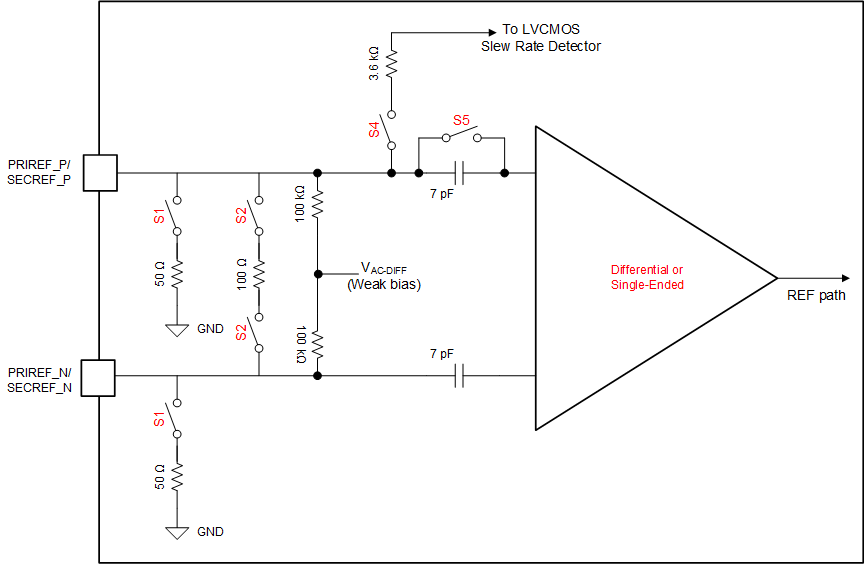JAJSTE0 March 2024 LMK05318B-Q1
PRODUCTION DATA
- 1
- 1 特長
- 2 アプリケーション
- 3 概要
- 4 Pin Configuration and Functions
- 5 Specifications
- 6 Parameter Measurement Information
-
7 Detailed Description
- 7.1 Overview
- 7.2 Functional Block Diagram
- 7.3
Feature Description
- 7.3.1 Oscillator Input (XO_P/N)
- 7.3.2 Reference Inputs (PRIREF_P/N and SECREF_P/N)
- 7.3.3 Clock Input Interfacing and Termination
- 7.3.4 Reference Input Mux Selection
- 7.3.5 Hitless Switching
- 7.3.6 Gapped Clock Support on Reference Inputs
- 7.3.7 Input Clock and PLL Monitoring, Status, and Interrupts
- 7.3.8
PLL Relationships
- 7.3.8.1 PLL Frequency Relationships
- 7.3.8.2 Analog PLLs (APLL1, APLL2)
- 7.3.8.3 APLL Reference Paths
- 7.3.8.4 APLL Phase Frequency Detector (PFD) and Charge Pump
- 7.3.8.5 APLL Feedback Divider Paths
- 7.3.8.6 APLL Loop Filters (LF1, LF2)
- 7.3.8.7 APLL Voltage Controlled Oscillators (VCO1, VCO2)
- 7.3.8.8 APLL VCO Clock Distribution Paths (P1, P2)
- 7.3.8.9 DPLL Reference (R) Divider Paths
- 7.3.8.10 DPLL Time-to-Digital Converter (TDC)
- 7.3.8.11 DPLL Loop Filter (DLF)
- 7.3.8.12 DPLL Feedback (FB) Divider Path
- 7.3.9 Output Clock Distribution
- 7.3.10 Output Channel Muxes
- 7.3.11 Output Dividers (OD)
- 7.3.12 Clock Outputs (OUTx_P/N)
- 7.3.13 Glitchless Output Clock Start-Up
- 7.3.14 Clock Output Interfacing and Termination
- 7.3.15 Output Synchronization (SYNC)
- 7.4 Device Functional Modes
- 7.5 Programming
- 8 Application and Implementation
- 9 Device and Documentation Support
- 10Revision History
- 11Mechanical, Packaging, and Orderable Information
7.3.2 Reference Inputs (PRIREF_P/N and SECREF_P/N)
The reference inputs (PRIREF and SECREF) can accept differential or single-ended clocks. Each input has programmable input type, termination, and AC-coupled input biasing configurations as shown in Figure 7-7. Each input buffer drives the reference input mux of the DPLL block. The DPLL input mux can select from any of the reference inputs. The DPLL can switch between inputs with different frequencies if the inputs can be divided-down to a common frequency by DPLL R dividers. The reference input paths also drive the various detector blocks for reference input monitoring and validation.
 Figure 7-7 Reference Input Buffer
Figure 7-7 Reference Input BufferTable 7-2 lists the reference input buffer configurations for common clock interface types.
| xxxREF_TYPE (R46[3:0] / R46[7:4]) | xxxREF_DC_ MODE (R40[2] / (R40[3]) | INPUT TYPE | INTERNAL SWITCH SETTINGS | ||
|---|---|---|---|---|---|
| INTERNAL TERM. (S1, S2)(1) | LVCMOS SLEW RATE DETECT (S4)(2) | LVCMOS INTERNAL AC CAPACITOR BYPASS MODE (S5)(3) | |||
| 0x00 | 0x00 | Differential (externally DC- or AC-coupled, internally AC-coupled) | OFF | OFF | OFF |
0x03 | 0x00 | Differential (externally DC- or AC-coupled, internally terminated with 100Ω and AC-coupled) | 100Ω | OFF | OFF |
| 0x04 | 0x00 | HCSL (externally DC-coupled, internally terminated with 50Ω and AC-coupled) | 50Ω | OFF | OFF |
0x08 | 0x00 | LVCMOS (externally DC-coupled, internally AC-coupled) | OFF | ON | OFF |
0x08 | 0x01 | LVCMOS (externally DC-coupled, internally DC-coupled) | OFF | OFF | ON |
0x0C | 0x00 | Single-ended (externally DC-coupled, internally terminated with 50Ω and AC-coupled) | 50Ω | ON | OFF |